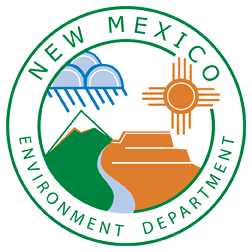Contaminants present in water may be taken in by organisms that live in the water, including fish. The Environment Department recommends eating fish that are low in contaminants. Fish consumption advisories are designed to reduce the risk of adverse health effects or health problems from eating fish caught in New Mexico waters.
There are no contaminant-related health risks from activities like catch-and-release fishing, swimming, boating, or camping in and around waters that have fish consumption advisories.
The Environment Department periodically collects fish from water bodies across the state and analyzes those fish for contaminants. Based on the results, we develop recommendations for fish consumption (expressed in meals per month). The most recent advisories replace previously issued advisories.
In some New Mexico fish, three particular contaminants have been detected at levels that could result in health problems from long-term (i.e. weeks, months, or years) fish consumption. These contaminants are mercury, polychlorinated biphenyls (PCBs), and dichloro-diphenyl-trichloroethane (DDT). Eating fish for which there is a consumption advisory may not make you feel sick, but long term consumption of such fish could increase your risk for some health problems. More information about these contaminants and potential health effects is available on the EPA’s website here.
Click here to see current fish advisories.
How to Use the Fish Consumption Advisories Table
- Determine the species and length (in inches) of your fish.
- Refer to the chart to find the lake or river where you caught your fish.
- Find the species (row) and size (column) of your fish.
- The number in the corresponding box is the number of meals per month that you can safely consume (we define a meal as a pre-cooked weight of 8 ounces of fish). If the number in the box is 1/2 it means one meal every two months.
- “No Advisory” means you can eat as much as you want.
- “0” means that we recommend that you DO NOT EAT ANY fish of that species and size class.
- If the box is blank, it means that we have not analyzed that particular species and size class at that location.
- If your fish is larger than the largest listed for that species and location, you should assume a smaller number of meals per month is advisable.
- If you eat the number of meals indicated in a cell, you have eaten the maximum amount recommended from all sources (don’t combine cell numbers).
- If your location or species is not listed, assume that smaller fish are generally lower in contaminants, and follow the information under “Cleaning and Preparation of Fish.”
Some of the fish sizes listed in this advisory are below the legal size limit as established by the New Mexico Game Commission. These advisories are for consumption limits only and do not supersede regulations pertaining to size or possession limits.
Cleaning and Preparing Fish
You can remove much contamination by properly cleaning and preparing the fish you catch. This is particularly true for PCB- and DDT-contaminated fish. Handling fish will not result in exposure to dangerous levels of contaminants.
First, you should remove the skin, fat, and internal organs. When cooking fish, you can reduce the amount of PCBs and DDT stored in the fatty portion of the fish by grilling, baking, or broiling and letting the fat drip away. However, avoid frying fish, because frying seals in contaminants that may be in the fish’s fat.
Mercury is not stored in the fish’s fat, so there is no cleaning or cooking method that will reduce the amount of mercury in fish.

